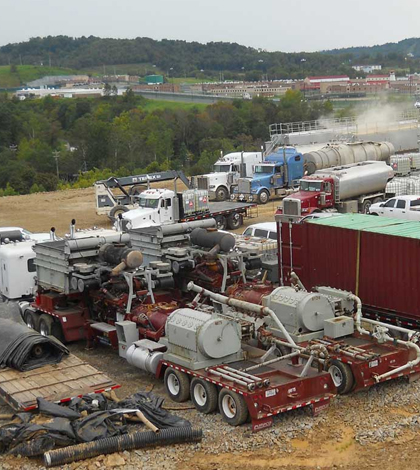Study Looks At Probability Of Methane Leakage From Hydraulic Fracturing

A fracking operation on the Marcellus Shale Formation in Pennsylvania. (Credit: Public Domain)
Until recently, debates about methane leakage from hydraulic fracturing have only been speculative. But a study from the University of Vermont seeks to change the discussion.
Professor George Pinder and doctoral student Jim Montague, both of the College of Engineering and Mathematics, have published new research in the Water Resources Research journal in October, which looks at how methane is traveling through abandoned mines and leaking out into the atmosphere.
An estimated 70,000 oil and gas wells have been drilled in the state of New York. But only 40,000 have been recorded. With 30,000 existing wells missing, it becomes precarious territory for new hydraulic fracturing operations. And the same issue persists in many states along the east coast.
Montague and Pinder were motivated by the debate, which led to the statewide ban of fracking in New York. They hoped to weigh in on the decision with scientific evidence, but were a little late to the game, as the ban was put in place in June 2015.
They used what they knew about the existing wells including their location and depth based on records dating back to the 1980s. They then made computer models to make large-scale simulations to determine the probability of encountering an existing well and the probability that methane would find its way in.
They were able to determine from these models that the risk of intersecting with an existing well is as high as 3.45 percent. They also determined that methane is able to escape when the well heads of old wells have not been cased properly.
“The method of construction has changed over the years, so over time there are multiple pathways that can form either within casing or the surrounding rock,” said Montague. “So in general when wells are abandoned, they have to be sealed with cement in order to isolate any hydrocarbon-producing formations from the surface. Over time, it’s possible that the concrete cracks or shifts, as well as the cement that is poured between the casing and the rock.”
Montague also adds that some of the existing wells were never cased at all, because proper regulations were not in place when the wells were shut down. When the casing isn’t present or is cracked or broken, the methane has a much easier path to the surface.
As for the debate about liquids reaching the surface, or more importantly, groundwater sources, that is yet to be determined. But Montague said the probability that something like that occurs is slim.
“Basically the rock acts like a sponge and will keep liquids in place, whereas the gas is driven by buoyancy and will naturally migrate upwards,” said Montague.
Montague stresses the importance of understanding this risk for hydraulic fracturing operations for the safety of the surrounding community, but also to prevent release into the atmosphere, which has contributed to climate change.
Because this study is one of the first to look into methane leakage, there is a lot to be determined still, such as the volume of methane that is actually leaking and other environmental risks at play.
“This is the first quantitative study of the impact of this phenomenon,” said Pinder. “Until we did this work, it was one person’s opinion versus another person’s opinion without any concrete numbers to work with.”
Montague and Pinder are eager to expand on the research and are hoping to work with industries and environmental organizations to assess the possible risks associated with their findings.
Top image: A fracking operation on the Marcellus Shale Formation in Pennsylvania. (Credit: Public Domain)




0 comments